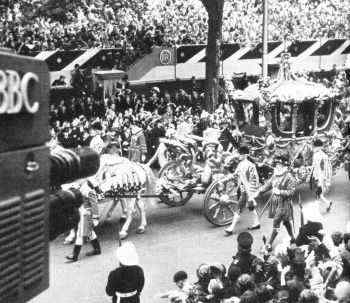
Home > Adults' Programmes > The Coronation
The Coronation of Queen Elizabeth II

The Queen's Coronation on June 2, 1953 in Westminster Abbey ushered in the television age. Permission had never been given before for television cameras in the Abbey. Some felt it wrong for people to watch such a solemn occasion while drinking tea in their front rooms. An estimated 20 million TV viewers saw the young Queen crowned.
Peter Dimmock played a major part in organising the overall television coverage and produced the televising of the Coronation Service from Westminster Abbey.
Cameras had been allowed inside the Abbey as a result of an intervention by the Queen herself. The Coronation Joint Executive Committee was the body ultimately responsible for the Coronation arrangements and epitomised the Establishment of the times. This august group decided in the summer of 1952 that to have live television inside the Abbey during the Coronation would impose an intolerable emotional strain on the young Queen. The bright lights and their heat could easily prove to be a disastrously heavy burden on a long exhausting day. Moreover, it would deprive a then privileged class of peers and peeresses of the exclusive opportunity of witnessing at first hand the crowning of the new Queen. The Cabinet reviewing the Coronation arrangements on 10 July 1952, agreed that no facilities should be provided for television inside the Abbey. When Sir Winston Churchill conveyed to the Queen in October the unanimous view of her leading advisors, and of the Cabinet, that she should not be subjected to the ordeal of live television during the Coronation, she courteously reminded him that it was she who was being crowned, not the Cabinet, and she felt that all her subjects should have the opportunity of seeing it.
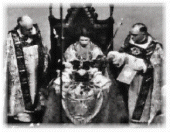
The Television Commentators
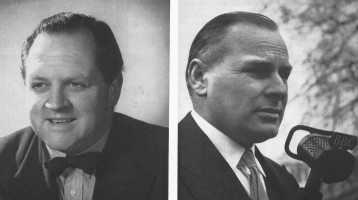
Richard
Dimbleby was perhaps the best known of all BBC
commentatotrs on sound and television. For viewers he described
the historic scene in the Abbey. Chester Wilmot,
author of The Struggle for Europe, hailed from Melbourne
and had many broadcasts to his credit. On the day, he described
the scene outside Buckingham Palace.
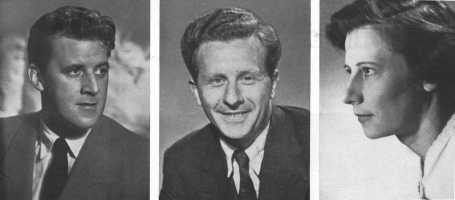
Bernard
Braden, Canada's representative in the television team
at Hyde Park, came to this country in 1949, and rose rapidly to
stardom in radio and on the West End stage. Michael
Henderson, television producer and commentator with many
sporting assignments to his credit, was outside the Abbey with Mary
Hill, one-time newsreader in Delhi for All-India Radio,
who had been heard in many roles in the Light Programme's 'Woman's Hour'.
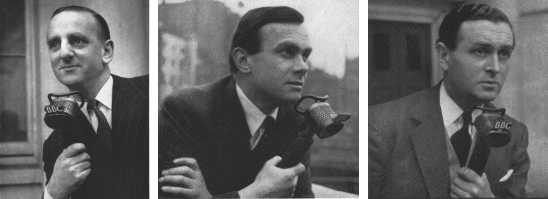
Brian
Johnston, an ex-Guards' officer, made his name in 'Let's
Go Somewhere' stunt broadcasts on 'In Town Tonight'. A devotee of
cricket and the theatre. Max Robertson had had
much experience as an all-round commentator on sound and
television, and was best known perhaps for his tennis
commentaries from Wimbledon. Berkeley Smith, who
joined television outside broadcasts as a producer in 1949 and
started commentating and interviewing in the summer if 1950, was
outside Buckingham Palace.
 audio clip from Richard Dimbleby's
commentary
audio clip from Richard Dimbleby's
commentary
Canberra jet bombers were used to take the film recordings for showing in USA and Canada in the evening.
The combination of Dimmock's impeccable camera direction and Dimbleby's felicitous words, together with the pageantry and above all the bearing of the young Queen, assured a television triumph.
The marathon outside broadcast was transmitted from 10:15am to 5:.20pm.
BBC television licences rose by 50 percent in the following year.
More information about how the Coronation was televised
The Official British Monarchy Website
How the Coronation kick-started the love of television
|
If you have any comments or further information of interest, please e-mail webmaster@whirligig-tv.co.uk